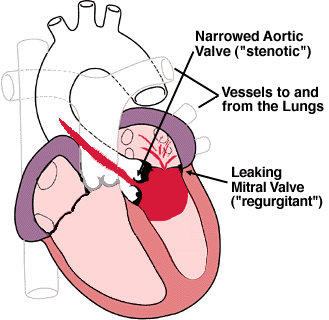HeartPoint animation: this will take approximately 1 minute to load.

Endocarditis
HeartPoint animation: this will take approximately 1 minute to
load.

What is "Endocarditis"?
Endocarditis is an infection of the heart valves and parts of the inside lining of the heart muscle (known as the "endocardium"). This is an uncommon, but not rare, infection. It is often very serious. The infection may begin at the time of a dental or medical procedure in someone who has a predisposing abnormality of their heart. It may also occur in someone who has had no previous problem with their heart, and who has not had any other procedure which is associated with a risk of endocarditis.
Bacteria often find their way into our blood in the midst of our normal day. Activities such as chewing or having a bowel movement typically push some bacteria into the bloodstream. The body has set up elaborate and effective ways of dealing with these events the most important of which is a smooth and continuous surface throughout the heart and blood vessels. Bacteria simply have no place to attach, and if they do, the body can kill the bacteria promptly.
If a large number of bacteria enters the bloodstream and a condition exists, such as some types of valve deformities, the bacteria can gain a foothold on an area where the lining is not perfect. Once the bacteria have "set up shop", they have access to a wonderful source of nutrition -- the patient's bloodstream which contains all of the materials they could want.
The bacteria can form "vegetations" on the valve they infect. These vegetations are often only lightly adherant to the valve, and may break off into the blood stream. These can act like clots, blocking off flow in the arteries where they travel. Furthermore, they can spread the infection to multiple places in the body.
A person with this type of infection may initially have only vague and mild symptoms which are ignored by the patient or misdiagnosed by the healthcare practitioner. On the other hand, if the infecting bacteria is a very aggressive type, the patient may be severely ill from the onset.
This condition requires long-term antibiotics (often four-to-six weeks, or more) and may require valve replacement. Also, see the next section on prevention.
Do I need to take antibiotics prior to dental work and other procedures?
Antibiotics are often prescribed prior to some dental and medical procedures for people with certain conditions. People who require this have a heart or other condition that makes it easier for an infection to occur. They are given the antibiotics prior to procedures that are associated with bacteria being released into the bloodstream.
Not all people, even those with heart conditions, need to take antibiotics. Furthermore, even if antibiotics are used, they are not used for simply any procedure. An outline of some of the factors involved is listed below.Cardiac conditions associated with risk for Endocarditis
This is best conceived of as a spectrum of risk.
Highest risk
Artificial heart valves
Prior episodes of endocarditis
Some complex congenital heart defects and repairs
Moderate risk
Some less complex congenital defects
Patent ductus arteriosus, Ventricular septal defect, "Primum" atrial septal defect,
coarctation of the aorta, bicuspid aortic valve
Hypertrophic cardiomyopathy
Some cases of rheumatic or other types of valvular heart disease
Mitral valve prolapse with mitral regurgitation
Low risk (equal to people without underlying cardiac defects)
"Secundum" atrial septal defects
Atrial or ventricular septal defect, or patent ductus arteriosus surgically closed greater than 6 months
"Innocent" heart murmurs
Prior bypass surgery
Mitral valve prolapse without regurgitation
Persons with pacemakers or implantable defibrillators
History of rheumatic fever without residual problemsFor which procedures should antibiotics be taken?
The list is long, and more importantly, very specific. For this latter reason, I am not including it here. You may access the entire and current recommendations on the American Heart Association site. http://www.amhrt.org/.
A good rule of thumb is to remind anyone who is to do a procedure to you that you have a condition that requires antibiotic prophylaxis in some cases, and ask them specifically about the one they are about to do to you.
©COPY;1997 HeartPoint Updated May 1998
| Commentary |
Food You Will Love | HeartPoint
Gallery | In The News | Health Tips | What's New
| Information Center | Home
|
This site presents material for your information, education and entertainment. We can assume no liability for inaccuracies, errors, or omissions. Above all, material on this site should not take the place of the care you receive from a personal physician. It is simply designed to help in the understanding of the heart and heart disease, and not as a diagnostic or therapeutic aid. You should seek prompt medical care for any specific health issues. Please feel free to browse the site and download material for personal and non-commercial use. You may not however distribute, modify, transmit or reuse any of these materials for public or commercial use. You should assume that all contents of the site are copyrighted. ©COPY;1997 HeartPoint